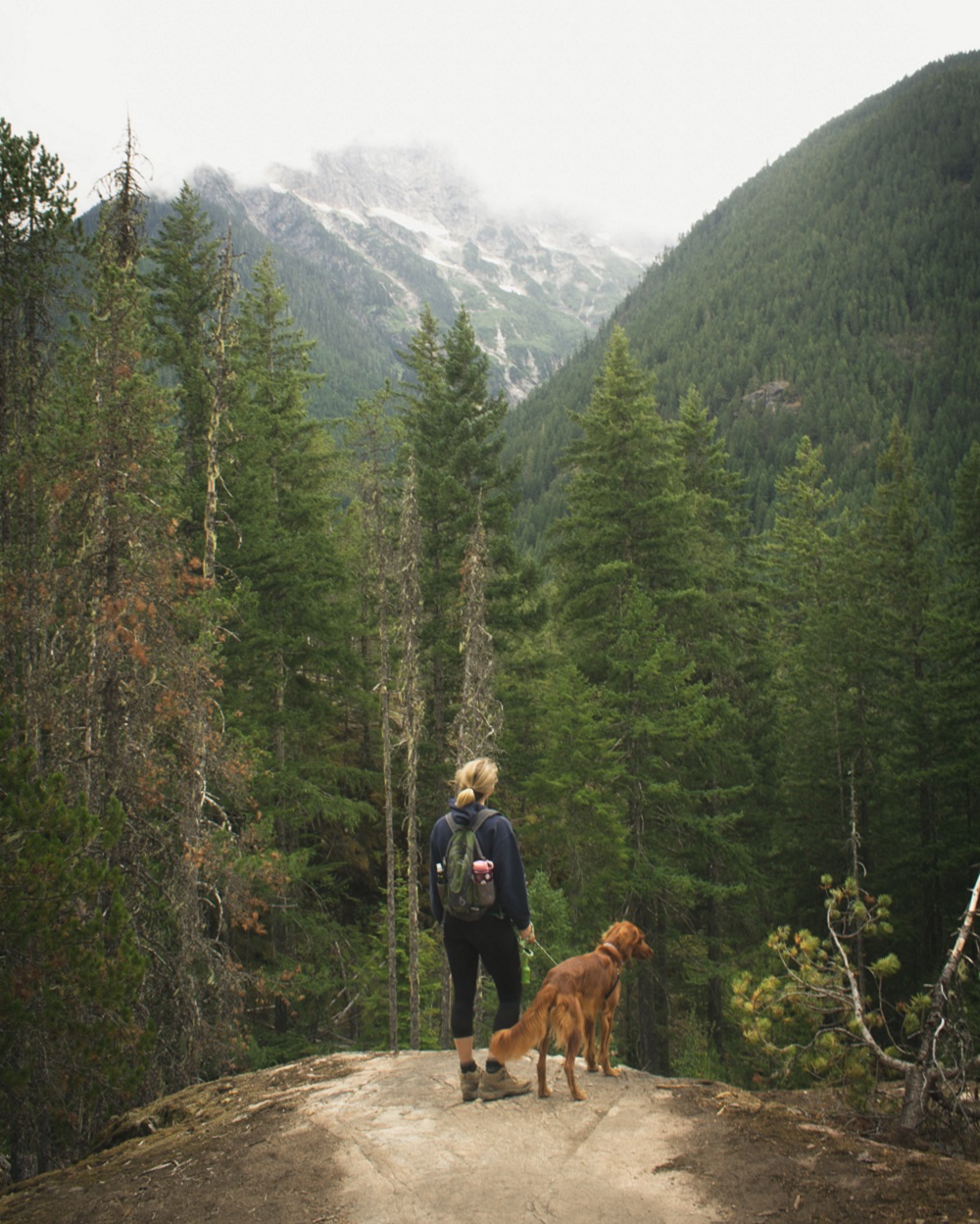The Essential Guide for Hiking With Your Dog

Hiking is fun and is more enjoyable when you involve your canine friend. Apart from exposing your dog to new sights, smells and sound, hiking offers several cardiovascular benefits to you and your pooch. This is vital in combating stress. If you’re planning for a hike this coming fall, then consider walking your four-legged friend. Most dogs can walk for about 10 miles a day which is an excellent therapy for them. Some dogs can go up to 15-20 miles per day depending on your dog’s health and breed.
Preparing for a hike with your dog
Now that you’ve laced up your boots, pack your warm clothes and a few bottles of water, what have you done to your furry hiking companion? If it’s your first time taking your dog out, then it can be a bit challenging to understand how to prepare your dog. However, we’ve compiled a detailed list of tips and things to know before you hike with your dog.
The Essentials:
Verify whether dogs are allowed to hike on the trails
Not all trails will enable you to walk with your dog. Whether it is a park or open space, do proper consultation to know whether dogs are allowed. Regional and national parks are considered more dog-friendly compared to state parks. First, conduct prior research and take steps to familiarize and understand all the restrictions surrounding dog hiking. Some parks require that all dogs be leashed. Even if the park you’re hiking it doesn’t have any leash laws, it is good to have one. It all depends on the behavior of your dog. If the park allows you to off-leash your dog, then you can allow him off, but remember to keep him by your side. You can only do it if your dog is well-mannered.
The type of leash to choose depends on the kind of terrain you’ll be hiking in. If it is just an open space, then consider using a standard leash. If you are hiking on rugged terrain, then better opt for a stronger and durable nylon leash.
Some parks require dogs to have ID tags that specify the name of your dog and contact information. This is critical in case your dog gets lost during the hike. Always check with the managing agency of the park or trail system to avoid possible issues otherwise you can turn your hike into a costly one.
Safety is paramount
You don’t want your dog to fall ill or contract diseases while hiking. Pack the right stuff in your travel bag. Things such as drinking water, enough food, sunscreen, first aid kit, and phone are the essential stuff that should not miss in your best osprey backpack.
Sunscreen is necessary mainly for dogs that have light-colored noses. They are vulnerable to sunburns which can cause skin cancer.
Some of the first aid items to have include gauze pads topical disinfectants, bandage tape, and tweezers. It is also good to have your vet’s contacts handy. This will help you in case your dog falls ill.
When hiking, don’t let your dog interact with other wildlife, dig or destroy plants. There are all sorts of animals in the wild, and some may harm your dog. Rattlesnakes are very common in most states and hiking paths. Remember to keep your dog far from dangerous lakes, rivers, caves, grassy areas and piles of dead branches.
Dress him properly
Remember to choose an appropriate dress. For cold weather, take an extra layer of dog’s clothing to keep your dog warm. During summer, take cool clothing such as a scarf or other light clothes. An orange vest is also recommended especially during hunting season. This can make your dog stand out unique.
If your dog is hiking barefooted without any protection, then remember to check his paws. Some sharp rocks and twigs may hurt your dog. Even in cold weather, the paws of your dog can chaff. For deep wounds or other severe condition or ailment, be sure to see your vet. To understand this, pay close attention to the behavior of your dog as you hike on the trails. It is easy to know when your dog is tired or have been hurt. If for any case your pet is injured, don’t walk him further. Carry him out if the condition doesn’t allow him to walk.
Consider the age of your dog
The age of your dog is critical when determining the distance you can walk him. If your dog is below one year, then it means it is still developing its bones and muscles. Such a dog doesn’t qualify for long hikes or more than six hours — similarly, not all senior dogs like the idea of long walks. You can gauge this by examining the physical behavior. A lack or decline in their physical prowess can signal some tiredness.
Hiking in areas with hot temperatures can be risky for your dog. In case you are in doubt, we advise you to keep your dog at home. When hiking during warm days, be sure to take breaks and ensure your dog is adequately hydrated. If your dog is tired, relax and stay in the shade for a while. Unlike human beings, dogs don’t sweat. They depend on panting to release the extra heat from their bodies. This is why most of them experience heat stroking and exhaustion. If your dog has short muzzles, then there are high chances it could be sensitive to heat. Heat-sensitive dogs should not hike for long under hot temperatures.
Feed him properly
It pays to stick to your dog’s feeding schedule. However, it requires proper planning because most of the time you’ll be outdoors. Remember to carry the right food that your dog loves. Some dogs are very active and will need a lot of energy to walk around. At certain points, you might need to make frequent stops to feed your canine. Smaller meals during the day can work especially if you have an active dog. Carry enough drinking water. A collapsible bowl is also good for this. Don’t let your dog drink water along the rivers or streams. They may contain bacteria which can make him fall sick. Frozen bottles of water are great, and you can pack them in your bag if the weather is hot.
Consider the behavior of your dog when around strangers
Taking your dog for a hike is fun. However, dogs behave differently when in busy places. In case you are hiking on busy and crowded trails, then an aggressive dog will be more likely to feel afraid and nervous. Off-peak periods are the right times to walk with dogs that are slightly nervous and afraid of strangers.
Be aware of the hiking environment
The last thing you’ll want to experience is to get lost in the middle of nowhere with your pet. This is why it pays to plan your hike on the trails. Have a clear path of where you’ll be hiking. Forging your way through the wilderness can put you and your pet at risk. You might encounter wild animals, and some might want to prey on your pet. Animals such as skunks and porcupines can be hazardous on your dog. When scared by a dog, these animals can become agitated.
Arrange for your dog’s sleeping needs
After the day’s hike, you and your dog will be exhausted. If you are camping outdoors, think about your dog’s sleeping needs. Will your dog be sleeping inside or outside the tent? A blanket and a small foam mattress would be ideal for inside tent sleeping. The tent floor can be protected and the sleeping surface made warm. However, you will need to introduce your dog to the tent first.
Letting your dog sleep outdoors comes with its perils. This is because there is the risk of wild animals and mosquitoes that may harm your dog. In case you’re considering outdoor sleeping, then you’ll need to factor in some things.
Minimize the traces
Although most of us dislike the idea of cleaning up the mess, it is good to leave the trail as clean as you found. This helps to prevent disease spread and other hazards when hiking in protected parks. For your safety, carry some tough but small plastic bags that you can store your dog’s waste then dispose of in the right places. For overnight hikes, a small shovel can help. You can use it to dig small holes where you can dispose of your dog’s waste. Although this might require an extra effort, it helps to keep the hiking trails safe and healthy.
Do a post-hike check
Some dogs can be very tough. They may not show any signs of hurt or tiredness during the hike. After the walk, consider doing a health check. Are there any signs of limping, lumps or sensitivity issues? In case you took a hike during a hot and dry day, then remember to give your pooch a quick bath.
Conclusion
The best treatment you can give your best canine friend is taking him out for a hike. However, taking your dog for a walk isn’t always as simple as it may sound. You need to do proper planning by choosing the right hiking trails, how you’ll feed your dog during the hike, how long you will hike, your safety and sleeping needs and much more. The above are the things you need to know before hiking with dogs. Visit our website to learn more about hiking with your dog.





